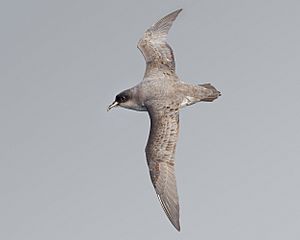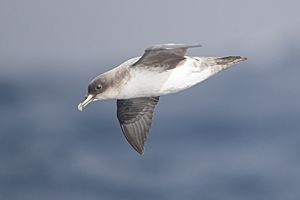Grey petrel facts for kids
Quick facts for kids Grey petrel |
|
|---|---|
 |
|
 |
|
| Conservation status | |
| Scientific classification | |
| Genus: |
Procellaria
|
| Species: |
cinerea
|
The grey petrel (Procellaria cinerea), also known as the brown petrel or pediunker, is a type of seabird. It belongs to the petrel family, called Procellariidae. These birds live in the open waters of the Southern Hemisphere, mostly between 58°S and 32°S.
Contents
About the Grey Petrel
The grey petrel is part of a group of birds called Procellariiformes. These birds have special features that help them live in the ocean. For example, they have unique nostrils on top of their bills. Their bills are also made of several strong plates.
These petrels can make a special "stomach oil." This oil is stored in their stomach and can be sprayed out to protect themselves from predators. It's also a super-rich food source for their chicks and helps adult birds during long flights. They also have a salt gland above their nose. This gland helps them remove extra salt from their bodies, which they get from drinking ocean water. They get rid of the salt through their nose!
The grey petrel has a few different names. People sometimes call it the pediunker, grey shearwater, or brown petrel.
What's in a Name?
The scientific name for the grey petrel, Procellaria, comes from two Latin words. Procella means "storm," and arius means "pertaining to." This name was given because these birds are often seen during stormy weather.
The word "petrel" comes from the story of Saint Peter walking on water. This is because petrels often look like they are running on the water when they take off to fly.
What Does it Look Like?
The grey petrel is a large bird with grey, white, and brown feathers. They are about 48 cm (19 in) long and weigh around 1,000 g (35 oz).
Their upper parts, like their back and upper wings, are brownish-grey. Their belly and the underside of their wings are white or ash-grey. They have a yellow-green bill and pink-grey feet.
How Do They Live?
Grey petrels have interesting ways of living and raising their young. Their populations are decreasing in many places. For example, on Gough Island, there were over 10,000 pairs in 2004, but their numbers are going down. On Antipodes Island, there were nearly 49,000 pairs in 2010, but their numbers are also declining.
Reproduction and Family Life
Grey petrels make their nests on several islands. These include Tristan da Cunha, Gough Island, the Prince Edward Islands, Crozet Islands, Kerguelen Islands, Macquarie Island, and New Zealand's Campbell and Antipodes Islands.
They usually come back to these islands in February and March. They dig a burrow in the ground for their nest. These burrows are often on steep, well-drained land, sometimes among tall grass.
By late March or early April, the female petrel lays one egg. Both parents take turns sitting on the egg to keep it warm. After the chick hatches, both parents care for it. The young bird stays in the nest until it is ready to fly, which happens between late September and early December.
What Do They Eat?
Grey petrels are great divers! They can dive from heights of up to 10 m (33 ft) into the water to catch their food. They mainly eat cephalopods, which are sea creatures like squid and octopuses.
Where Do They Live?
Grey petrels spend most of their time in the open ocean, far from land. When they are not breeding, they usually stay between 49°S and 32°S.
During the breeding season, they gather in large groups called colonies on certain islands. The biggest colonies are on Antipodes Island (with about 53,000 pairs) and Gough Island (with 10,000 pairs). Other colonies can be found on Prince Edward Island, Marion Island, Tristan da Cunha, Crozet Islands, Kerguelen Islands, Amsterdam Island, Campbell Island, and Macquarie Island. These birds can be found over a huge area of ocean, about 68,800,000 km2 (26,563,829 sq mi).
Protecting the Grey Petrel
There isn't a lot of new information about the grey petrel's population. However, experts believe their numbers are slowly, or even quickly, getting smaller.
One big problem is predators that have been brought to their breeding islands. These include cats and different types of rats. Another major threat is longline fishing. This type of fishing can accidentally catch many birds, which is called bycatch. In New Zealand waters, the grey petrel is one of the most commonly caught birds by longline fisheries. Other animals like the weka and house mouse can also be predators.
To help protect the grey petrel, several actions have been taken:
- It has been listed on CMS Appendix II and ACAP Annex1. These are international agreements to protect wildlife.
- Gough Island, a key breeding site, has been named a World Heritage Site.
- On Antipodes Island, scientists started watching the bird's population closely in 2007.
- In 2001, brown rats were removed from Campbell Island, which helped the birds there.
- In 2006, the SEAFO made fishing rules stricter to protect seabirds.
In the future, more work is planned. This includes counting the birds at all their breeding spots. Scientists also want to study the house mice on Gough Island. Finally, they hope for even stricter fishing rules from organizations like the FAO and ACAP.
See also
 In Spanish: Pardela gris para niños
In Spanish: Pardela gris para niños


